Dear photography lovers!
We, the staff of the Pencil Printing Center, have been helping you visualize your memories in the form of photographs since 2006.
Despite the development of gadgets, many prefer the printed version of photos. A paper photo is not at risk of being lost due to a virus or accidental deletion, it will not run out of battery, it is easier to share it with friends during a home event. The framed family photo on the wall has never been replaced by a digital photo frame due to the fact that most people like the paper version more.
During this period, we printed your photos on a variety of printers: cheap, expensive, inkjet, laser, photochemical, sublimation and others.
Time is passing, technology is changing, and we can already call ourselves professionals in this field – we have printed millions of photos. We want to share our experience so that you can make an informed choice of the type of photo printing that suits your needs.
Ways to print photos
1. Photochemical photo printing.

It is available in the old version in the darkroom "in a dark room with a red lamp" or in an automated mini darkroom.
Positive:
- the usual type of print
- waterproof paper
- good light resistance
- good quality (when using high-quality consumables)
Minuses:
- non-ecological, harmful to the environment
- low print resolution (up to 400 dpi)
- limited photo sizes (up to 45 cm by 90 cm)
- a relatively long and expensive process
- inaccurate color rendering
The Pencil printing center thus prints photos from films and slides with the help of print partners.
2. Inkjet printing of photos.
The most important thing to understand when using inkjet photo printing is the difference between "water", "pigment", "eco–solvent" and "UV" inks.
Water ink has a slightly larger color coverage than pigment ink, but at the same time it quickly fades in the sun. In direct sunlight, water ink can burn out for a week beyond recognition, while such a photo can be stored for decades in a photo album on a shelf.
Pigment inks can remain resistant to the sun for up to 3 years, under normal conditions for up to 100 years, according to manufacturers. This difference in durability between pure water and pigment inks is due to the fact that the paint particles in pigment inks are enveloped in a thin layer of polymer that protects them from solar ultraviolet radiation.
Eco-solvent ink has emerged as a new eco-friendly variant of solvent ink. Such inks, due to the presence of acids in their composition, slightly dissolve the carrier itself and, thus, are very resistant to light, water and mechanical influences.
UV-curable ink is applied by the printer to the surface of the material and fixed by exposure to ultraviolet radiation. Thanks to the type of fastening, it is possible to print on almost any materials. Such inks are also environmentally friendly, resistant to light, moisture and mechanical influences.
None of the above types of ink are "friends" with ordinary paper (UV ink does it a little better). To print photos, it is necessary to use specialized materials that differ greatly in price and quality. High-quality paper for all types of inkjet photo printing used in Pencil printing centers is little affected by moisture, and even water ink practically does not spread when water enters.
In fairness, it is necessary to mention latex UV-curable inks, which have some advantages compared to the above, but the resolution and color reproduction are still insufficient for high-quality printing of photos, especially small ones.
Also, a very important point is the assumption that in this article we are talking about the original ink recommended by the manufacturers of a particular printer. With high-quality printing on "compatible" consumables, additional printer settings are required, both software and mechanical, while it is very difficult to achieve reliability and proper quality of printing photos.
2.1. Inkjet printing of photos on a home household printer.
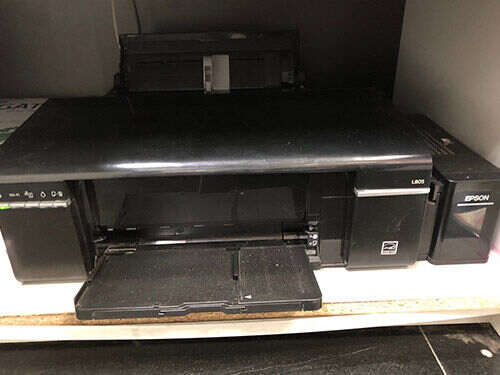
There are a huge number of household photo printers, most of which, with the right approach and the use of original consumables, can give very high-quality results. Such printers are most often printed with water ink, more expensive models can be pigmented.
Here, with a relatively low price of the printer (50-500 US dollars), there is usually a very high cost of ink and a short service life of the device itself. Also, due to the peculiarities of the technology, the print head can often become clogged. To ensure excellent quality, the real cost of photo printing at home on such printers ranges from 0.3 to 1.5 US dollars per 10x15 print.
Positive:
- excellent color reproduction
Minuses:
- low resistance to sunlight
- low print speed
- high cost price
In Pencil printing centers, such printers are used to print photos on documents.
2.2. Inkjet printing of photos on a specialized photo printer with water ink.
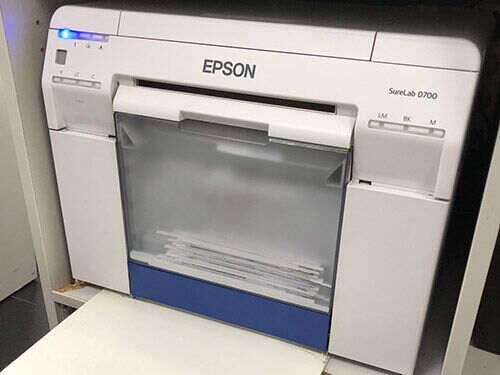
Such printers have been specially developed by several manufacturers, aimed at replacing traditional photochemical minifotolabs. In terms of print quality, they differ little from household ones, but their increased reliability and durability, combined with cheaper consumables and high speed, makes printing on such devices justified.
Positive:
- high print speed
- excellent color reproduction
- reasonable cost price
Minuses:
- low resistance to sunlight
In Pencil printing centers, such printers are used for urgent and standard photo printing.
2.3. Inkjet printing of photos on a specialized photo printer with pigment ink.
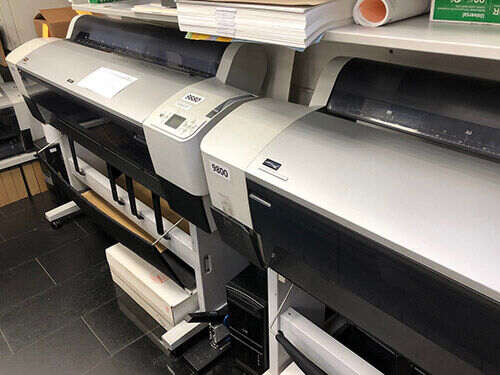
Professional pigment printers are required for high-quality printing of photos with pigment ink, especially large format photos (up to 1.1 by 5 meters). The difference between such printers is the presence of black and two or three gradations of gray for high–quality printing of black and white images and for the correct transmission of human skin color - one of the most difficult tasks in printing.
Also, the improved software allows you to accurately transfer colors with a resolution of up to 1440x2880 dpi with pigment ink.
Positive:
- the best color rendering
- high resistance to sunlight and moisture
Minuses:
- low print speed
- high cost price
In Pencil printing centers, such printers are used for premium photo printing.
2.4. Inkjet printing of photos on an eco-solvent photo printer with ink based on organic acids.
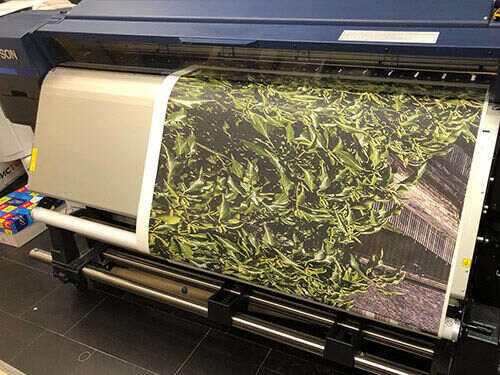
The color coverage of such a printer with original ink is almost identical to a professional pigment printer. Due to the larger size of the ink drop, its resolution is slightly lower – up to 1440x720 dpi, however, the cost of printing is much lower.
The maximum size of such a photo print is limited by the length of a roll of material with a width of 1.6 m.
In addition, special photo paper for printing photos on this printer is covered with a layer of plastic, which, coupled with the reliability of eco-solvent ink, allows us to hope for a very long life of the print. Also, it is possible to print on self-adhesive film, rolling it on various types of plastic, completely eliminating paper and completely avoiding paper shrinkage depending on humidity. This is how high-quality and durable reproductions and portraits are printed.
Positive:
- excellent color reproduction
- high resistance to light
- low cost
Minuses:
- low print speed
- small photos may lack resolution
In Pencil printing centers, such printers are used for standard printing of large-sized photographs, replacing an outdated photochemical process.
2.5. Inkjet printing of photos with UV-curable ink.
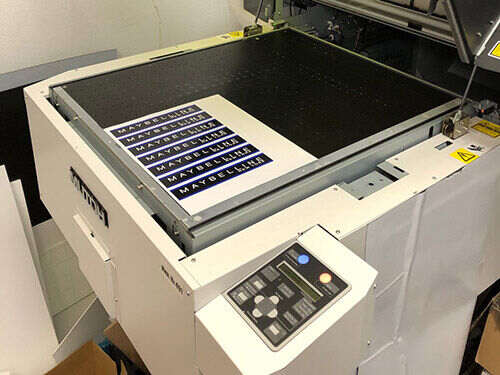
This type of inkjet photo printing is relatively young. Such printers print relatively slowly and relatively expensive, so the technology has not yet been widely used in photo printing. Such printing is voluminous to the touch, printing in white and transparent varnish is possible.
Positive:
- printing on any surfaces
- high resistance to light, moisture and mechanical influences
- medium-level color rendering
Minuses:
- high cost
- low print speed
- medium-level color rendering
In the Pencil printing centers, such printers are used to print photos on souvenir products, on plastics, on wood, on glass, as well as for printing premium printing products.
3. Sublimation printing of photos on paper.
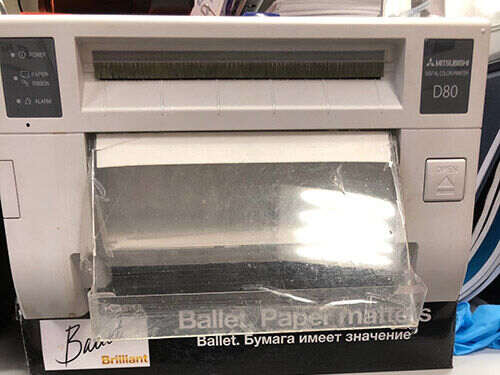
This type of photo printing is a sequential thermal transfer of dyes of different colors from films to paper.
After printing, a thin film resembling lamination is applied to the photo.
Positive:
- high print speed
- bright colors
- acceptable cost price
- average resistance to light, water and mechanical influences
Minuses:
- inaccurate color rendering
In Pencil printing centers, such printers are used to manufacture some photomagnets.
4. Laser printing of photos on a professional printer.
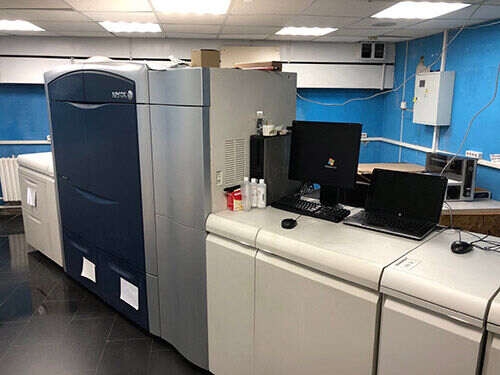
This type of printing is initially used in the printing industry, where the requirements for print quality are slightly different from photo printing. The process is a dry transfer of dry paints of four colors to paper and subsequent thermal fixation on paper.
However, modern professional A3+ laser printers (the printer occupies an area of 10 sq. meters, weighs one and a half tons and costs 60-250 thousand US dollars) allow you to achieve very good results in the quality of photo printing. The photos printed on these printers resemble postcards, and for the untrained eye the difference is small.
High-quality offset coated paper with a density of about 250g/m is used.
Positive:
- bright colors
- high resistance to light
- high reliability
- the lowest cost
Minuses:
- inaccurate color rendering in halftones and skin tones
- laser printing paper is exposed to moisture
In Pencil printing centers, such printers are used to print Digital photographs, offering consistently high print quality from snapshot to snapshot at the lowest price from 4 US cents per 10x15 photo.
In addition to printers on which photos are printed, software plays an equally important role, with the help of which self-ordering of photos via the Internet is carried out. A properly configured software process leads to accurate color reproduction, accurate dimensions, correct framing and no delays in photo processing.
The Pencil printing center uses proprietary software, and a specially licensed English software from a world leader in this field is responsible for the "photo image processing core". You can also order a photo in the Pencil printing center from your smartphone, and this can be done very quickly and conveniently. Facebook Instagram, Facebook, etc. can also be accessed directly from social networks.
In conclusion, I would like to express the hope that this article has helped you better understand the options for photo printing and make the right choice.




